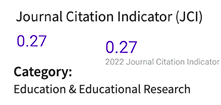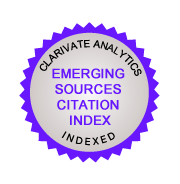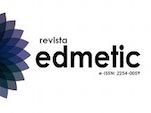Internet addiction in future teachers. A case study with university students
DOI:
https://doi.org/10.20548/innoeduca.2016.v2i1.1063Keywords:
INTERNET ADDICTION, IMPULSIVE BEHAVIOR, LATENT CLASS ANALYSISAbstract
Objectives. Some studies show a high consumption of Internet at any age. Internet use has spread to all places because mobile devices has more performance and conectivividad. The aim of this study was to analyze the degree of Internet addiction students of the Faculty of Education Sciences at the University of Málaga.
Method. We used a cross-sectional study to describe the case. The data collection instrument is a autocompletable online questionnaire. Anonymous and voluntary. 809 students responded (18.16% of total).
Results. The results show that Internet use by college students is widespread, especially through laptops and mobile phones, used at home and at the university. No significant differences with regard to gender, but there are differences with respect to age: younger students have higher levels of Internet addiction.
Conclusion. Internet addiction is not an alarming phenomenon in the sample, but a fact to which we must pay attention.
Downloads
Metrics
References
AIMC. (2014). Audiencia de Internet en el EGM. Recuperado 19 de enero de 2015, a partir de http://www.aimc.es/-Audiencia-de-Internet-en-el-EGM-.html
Barke, A., Nyenhuis, N., y Kröner-Herwig, B. (2012). The German version of the internet addiction test: a validation study. Cyberpsychology, Behavior, and Social Networking, 15(10), 534-542.
Bravo, A., y Paúl, C. (2014). Ciberbullying en estudiantes de bachillerato. Recuperado a partir de http://dspace.ucuenca.edu.ec/handle/123456789/20900
Caplan, S. E. (2003). Preference for Online Social Interaction A Theory of Problematic Internet Use and Psychosocial Well-Being. Communication Research, 30(6), 625-648.
Carbonell, X., Fúster, H., Chamarro, A., y Oberst, U. (2012). Adicción a Internet y móvil: una revisión de estudios empíricos españoles. Papeles del Psicólogo, 33(2), 82-89.
Chung, J. E. (2013). Social interaction in online support groups: Preference for online social interaction over offline social interaction. Computers in Human Behavior, 29(4), 1408-1414. http://doi.org/10.1016/j.chb.2013.01.019
Espinar, E., y González, M. J. (2009). Jóvenes en las redes sociales virtuales: un análisis exploratorio de las diferencias de género. Feminismo/s, 14, 87-105.
Fernández, J., Peñalva, A., y Irazabal, I. (2015). Hábitos de uso y conductas de riesgo en Internet en la preadolescencia. Comunicar: Revista científica iberoamericana de comunicación y educación, (44), 113-120.
Ferraro, G., Caci, B., amico, A. D’, y Blasi, M. D. (2006). Internet addiction disorder: an Italian study. CyberPsychology y Behavior, 10(2), 170-175.
Gracia, M. de, Vigo, M., Fernández, M. J., y Marcó, M. (2002). Problemas conductuales relacionados con el uso de Internet: Un estudio exploratorio. Anales de Psicología, 18(2), 273-292.
Guan, N. C., Isa, S. M., Hashim, A. H., Pillai, S. K., y Singh, M. K. H. (2015). Validity of the Malay Version of the Internet Addiction Test A Study on a Group of Medical Students in Malaysia. Asia-Pacific Journal of Public Health, 27(2), NP2210-NP2219.
Hawi, N. S. (2012). Internet addiction among adolescents in Lebanon. Computers in Human Behavior, 28(3), 1044-1053. http://doi.org/10.1016/j.chb.2012.01.007
Hawi, N. S. (2013). Arabic validation of the Internet addiction test. Cyberpsychology, Behavior, and Social Networking, 16(3), 200-204.
Internet World Stats. (2014). Internet Users in the World. Distribution by World Regions. Recuperado 19 de enero de 2015, a partir de http://www.internetworldstats.com/stats.htm
Khazaal, Y., Billieux, J., Thorens, G., Khan, R., Louati, Y., Scarlatti, E., … Zullino, D. (2008). French validation of the internet addiction test. Cyberpsychology y behavior, 11(6), 703-706.
Meerkerk, G.-J., Van Den Eijnden, R. J. J. M., Vermulst, A. A., y Garretsen, H. F. L. (2009). The Compulsive Internet Use Scale (CIUS): Some Psychometric Properties. CyberPsychology y Behavior, 12(1), 1-6. http://doi.org/10.1089/cpb.2008.0181
Moreno, M. A., Jelenchick, L. A., y Christakis, D. A. (2013). Problematic internet use among older adolescents: A conceptual framework. Computers in Human Behavior, 29(4), 1879-1887. http://doi.org/10.1016/j.chb.2013.01.053
Muñoz-Rivas, M. J., Fernández, L., y Gámez-Guadix, M. (2010). Analysis of the Indicators of Pathological Internet Use in Spanish University Students. Spanish Journal of Psychology, 13(2), 697-707.
Odaci, H. (2011). Academic self-efficacy and academic procrastination as predictors of problematic internet use in university students. Computers y Education, 57(1), 1109-1113. http://doi.org/10.1016/j.compedu.2011.01.005
ONTSI. (2014). Perfil sociodemográfico de los internautas (datos INE 2013). Recuperado 19 de enero de 2015, a partir de http://www.ontsi.red.es/ontsi/es/estudios-informes/perfil-sociodemogr%C3%A1fico-de-los-internautas-datos-ine-2013
Panayides, P., y Walker, M. J. (2012). Evaluation of the psychometric properties of the Internet Addiction Test (IAT) in a sample of Cypriot high school students: The Rasch measurement perspective. Europe’s Journal of Psychology, 8(3), 327-351.
Pramanik, T., Sherpa, M. T., y Shrestha, R. (2012). Internet addiction in a group of medical students: a cross sectional study. Nepal Medical College Journal : NMCJ, 14(1), 46-48.
Puerta-Cortés, D. X., Carbonell, X., y Chamarro, A. (2012). Análisis de las propiedades psicométricas de la versión en español del Internet Addiction Test. Trastornos Adictivos, 14(4), 99-104. http://doi.org/10.1016/S1575-0973(12)70052-1
Rodas, J. E., Vázquez, G. A., y Zhiminaycela, M. O. (2014). «Características del ciberbullying en los estudiantes de la Unidad Educativa César Dávila Andrade. Cuenca. Ecuador. 2013». Recuperado a partir de http://dspace.ucuenca.edu.ec/handle/123456789/5490
Rosen, L. D. (2012). iDisorder: understanding our obession with technology and overcoming its hold on us. New York: Palgrave Macmillan.
Urueña, A., Ferrari, A., Blanco, D., y Valdecasa, E. (2011). Las Redes Sociales en Internet. MIET. Recuperado a partir de http://www.ontsi.red.es/ontsi/sites/default/files/redes_sociales-documento_0.pdf
Wang, L., Luo, J., Bai, Y., Kong, J., Luo, J., Gao, W., y Sun, X. (2013). Internet addiction of adolescents in China: Prevalence, predictors, and association with well-being. Addiction Research y Theory, 21(1), 62-69. http://doi.org/10.3109/16066359.2012.690053
Widyanto, L., y Griffiths, M. (2006). ‘Internet addiction’: a critical review. International Journal of Mental Health and Addiction, 4(1), 31-51.
Young, K. S. (1998). Internet Addiction: The Emergence of a New Clinical Disorder. CyberPsychology y Behavior, 1(3), 237-244. http://doi.org/10.1089/cpb.1998.1.237
Downloads
Published
How to Cite
Issue
Section
License
All contents published by Innoeduca. International Journal of Technology and Educational Innovation are subject to Creative Commons Attribution-Nocomercial-NoDerivatives 4.0 International License, whose complete text can be consulted at https://creativecommons.org/licenses/by-nc-nd/4.0/legalcode. Thus, copying, distribution, public communication, derivative works and commercial use of content are permitted as of the aforementioned issue provided that the source and the author of the text are cited.
It is the responsibility of the authors to obtain the necessary permits for images that are subject to copyright.

This work is licensed under a Creative Commons Attribution-NonCommercial-NoDerivatives 4.0 International License.






1.jpg)


242.png)







